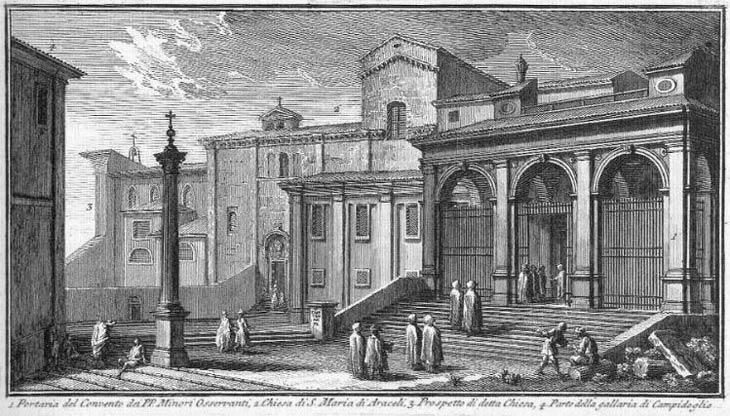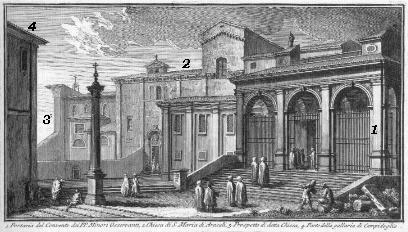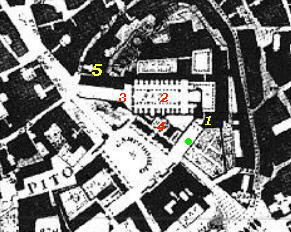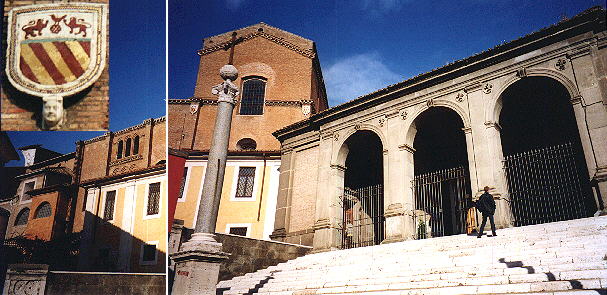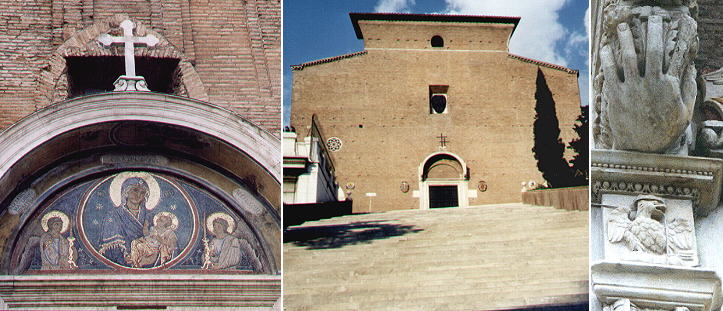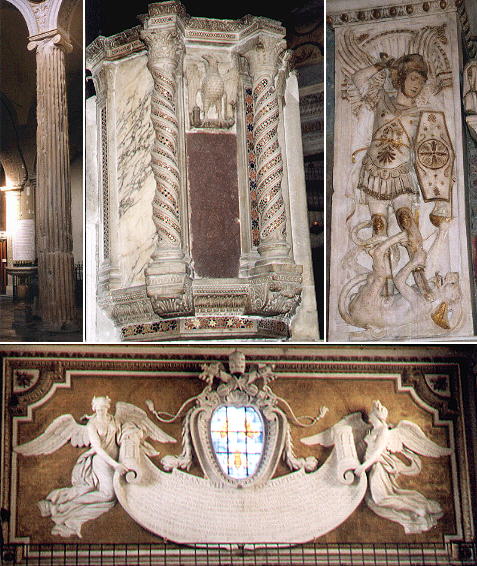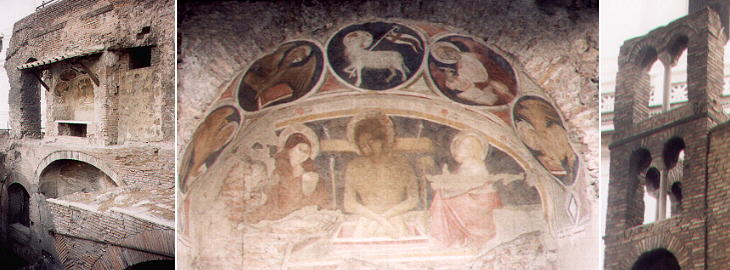

Chiesa di S. Maria in
Aracoeli (Book
7) (Map
B3) (Day 1) (View C8) (Rione Campitelli)
In this page:
The plate by Giuseppe Vasi
Today's view
Details of S. Maria in Aracoeli
S. Biagio in Mercatello
The Plate (No. 130 - ii)
In this plate Vasi chooses not to show the obvious view of the fašade
of S. Maria in Aracoeli: maybe because Romans (at least those who know
the city where they live) prefer reaching the church through the much easier
approach of Piazza del Campidoglio, rather than
climbing up the steep and dangerous steps which lead to the fašade. The view is taken from the green dot in the 1748 map below.
In the description below the plate Vasi made reference to: 1) Entrance to the Monastery; 2) S. Maria in Aracoeli; 3) Fašade of the church;
4) Part of Palazzo Nuovo. 4) is shown in another page. The small map shows also 5) S. Biagio in Mercatello.
Today
The church and the adjoining monastery show some minor changes such as
the coat of arms of the Savelli, a reminder of Honorius IV's tomb inside
the church. S. Maria in Aracoeli is very close to
Palazzo
Savelli. The loggia which gives access to the Franciscan monastery was built in the XVIth century by
Paulus III as entrance to his summer residence, but it was transferred to the friars by Sistus V.
S.
Maria in Aracoeli
Vasi forces perspective laws to show the entrance to the church where the baroque decoration is today
replaced by a XIIIth century mosaic. The western access to the church was built for the jubilee of the year 1350. The
porch on the fašade is not only interesting for the hand holding
the arch, but also for the heraldic eagle of the Mattei, another important
family having their Palace
close to the church.
The interior of the church contains memories of various periods:
the nave is borne by 22 different ancient
columns; the pulpit is a fine XIIIth century work; on the left part of the inner fašade
the tomb of Cardinal Lebretto (d. 1465) has an extremely elegant Renaissance relief of St George
by Andrea Bregno da Osteno and Gian Lorenzo Bernini designed in the inner fašade a gigantic baroque coat of arms in
honour of
Urbanus VIII: the shape of the window was rearranged to be consistent with
the traditional shape of a coat of arms so that the afternoon sun would
light up the bees of the Barberini.
S. Biagio in Mercatello
In his 1761 guide of Rome, Giuseppe Vasi wrote that the church of SS. Venanzio e Ansovino was
once known as S. Biagio in mercatello (mercatello being a reference to a fruit market held nearby).
The excavations of the 1930s which led to the removal of the church
of S. Rita at the foot of S. Maria in Aracoeli brought
to light that S. Rita had been built using some structures of the old church dedicated to S. Biagio. This church in turn
was built using in part the walls of a Roman insula a sort of five storey apartment block. While S. Rita was rebuilt
near Piazza Montanara the apse and the small bell tower of S. Biagio were left at the top of the
insula.
Excerpts from Giuseppe Vasi 1761 Itinerary related to this page:
Scala e Chiesa di S. Maria in Araceli
Molto cospicua, e celebre Ŕ la chiesa, che siamo per osservare; perci˛ non mancher˛ di
accennare tutti i suoi pregi. I marmi della altissima scalinata furono presi dalle rovine
del magnifico tempio di Quirino, come diremo a suo luogo; ed il sito della chiesa, si
crede da' pi¨, essere quello, ove stava il famoso tempio di Giove Capitolino, di cui
furono facilmente le molte colonne di granito egizio, che reggono la nave di mezzo,
tanto pi¨, che l'antica denominazione della chiesa ce lo suggerisce, e l'istoria ce
lo dimostra quasi ad evidenza, PoichŔ essendo il nostro Divino Redentore nato in tempo
di Ottaviano Augusto; questi avutane cognizione, secondo alcuni, da' libri Sibillini,
eresse in quel tempio un' altare col titolo di ARA PRIMOGENITI DEI: e secondochŔ
riferisce Dione, e Svetonio, essendo in quel tempo il Campidoglio pi¨ volte percosso da'
fulmini, Augusto volle ricorrere all'oracolo di Apollo Delfico, il quale per divina
disposizione rispose co' seguenti versi:
' Me Puer hebreus,
Divos Deus ipse gubernans,
Cedere fede jubet, tristemque redire sub Orcum ;
Aris ergo de hinc tacitus abscedito nostris.'
dalla cui risposta intimorito l'Imperatore inalz˛ nel tempio l'altare col suddetto
titolo, e si crede che fosse eretto, ove ora vediamo nella crociata di questa chiesa
l'altare isolato, che da Anacleto Antipapa nell'an. 1130. fu ornato con 4. colonne di
porfido, e poi nel 1603. dal Vescovo Cavalliense gli fu fatta la cupola con 8. colonne di
marmo.
Era quella gran chiesa una delle 20. Badie privilegiate di Roma, e la possedettero per
molto tempo i Monaci di s. Benedetto: ma Innocenzo IV. nell'anno 1253. la concedŔ ai Frati
di s. Francesco, i quali poi nel 1445. dividendosi tra Conventuali, ed Osservanti,
Eugenio IV. la concedŔ a quest' ultimi. Il Card. Oliviero Caraffa la ristaur˛ l'anno
1464. e dipoi il Popolo Romano vi fece il nobilissimo soffitto dorato, per ringraziamento
alla ss. Vergine della vittoria conseguita l'anno 1572. ai 20. di Ottobre dall' armata
Cristiana contro i Turchi, perchŔ in questa sogliono pigliar possesso i nuovi Conservatori
del Popolo Romano. Sono in questa chiesa varj depositi, e memorie antiche, e moltissime
cappelle ornate di marmi, di sculture, e di pitture antiche, e moderne, fra le quali
sono due quadri del Cav. Benesiani nella cappella di s. Margherita da Cortona, due del
Muziano, due di Pasqualino, ed una Madonna nel coro de' frati, che si crede opera di
Raffaelle da Urbino, gli altri si tralasciano per non pi¨ infastidire il Lettore; ma non
giÓ voglio omettere di indicare le pitture a fresco, che sono nel claustro di qualche
merito, e l'iscrizione della terza colonna vicino alla porta della chiesa, in cui si
legge A CUBICULO AUGUSTORUM.
|
Next plate in Book 7: S. Paolo alla Regola
Next step in Day 1 itinerary: Palazzi del Campidoglio
Next step in your tour of Rione Campitelli: Palazzi del Campidoglio

Go
to  or to Book
7 or to my Home
Page on Baroque Rome or to my Home Page on Rome
in the footsteps of an XVIIIth century traveller.
or to Book
7 or to my Home
Page on Baroque Rome or to my Home Page on Rome
in the footsteps of an XVIIIth century traveller.
|


